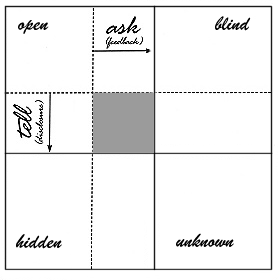Joseph Luft and Harry Ingham, 1955
|
|
|
|
|
||
|
|
|
||||
|
|
|
||||
|
|
|||||
|
|
|
||||
|
|
|||||
| The four panes of the window represent the following: |
- Open: The open area is that part of our conscious self – our attitudes,
behavior, motivation, values, way of life – of which we are aware and
which is known to others. We move within this area with freedom. We
are “open books”. - Hidden: Our hidden area cannot be known to others unless we
disclose it. There is that which we freely keep within ourselves, and that
which we retain out of fear. The degree to which we share ourselves
with others (disclosure) is the degree to which we can be known. - Blind: There are things about ourselves which we do not know, but
that others can see more clearly; or things we imagine to be true of
ourselves for a variety of reasons but that others do not see at all.
When others say what they see (feedback), in a supportive, responsible
way, and we are able to hear it; in that way we are able to test the
reality of who we are and are able to grow. - Unknown: We are more rich and complex than that which we and
others know, but from time to time something happens – is felt, read,
heard, dreamed – something from our unconscious is revealed. Then we
“know” what we have never “known” before.

